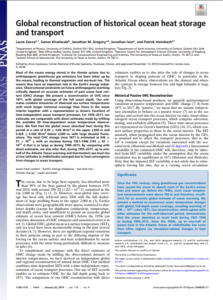According to a new research, global warming has heated the oceans by as much as one atomic bomb explosion per second for the past 150 years, Guardian reports. Namely, over 90% of the heat trapped by GHG emissions has been absorbed by the ocean.
As Guardian reports, oceans have absorbed more than 90% of the heat trapped by humanity’s GHG emissions. A little amount has heated the air and ice, while the majority is found into the oceans. This increases the sea level and leas to more hurricanes and more intense weather phenomena.
[smlsubform prepend=”GET THE SAFETY4SEA IN YOUR INBOX!” showname=false emailtxt=”” emailholder=”Enter your email address” showsubmit=true submittxt=”Submit” jsthanks=false thankyou=”Thank you for subscribing to our mailing list”]
Increasing sea level is among the most dangerous long-term impacts of climate change and it puts billions of people living in coastal cities at danger. For this reason, estimating possible rises is crucial to establish defences. Some of the rise derives from the melting of ice in Greenland and elsewhere in the world, but a key factor has been the expansion of water as it gets more warm.
Nonetheless, the seas do not warm at the same rate, because ocean currents transport heat around the world. Reconstructing the amount of heat absorbed by the oceans over the past 150 years will be able to provide a baseline. For example, in the Atlantic the research found that half the rise since 1971 resulted from heat transported into the region by currents, Guardian notes.
This new work aims to assist researchers predict better sea-level rise for different areas in the future, as changes in ocean transport could impact sea-level rise and risk of coastal flooding.
In order to predict global and regional climate change and sea-level rise, the world needs to understand ocean heat change and how circulation affects the patterns of warming.
For more information, click the PDF herebelow.































































